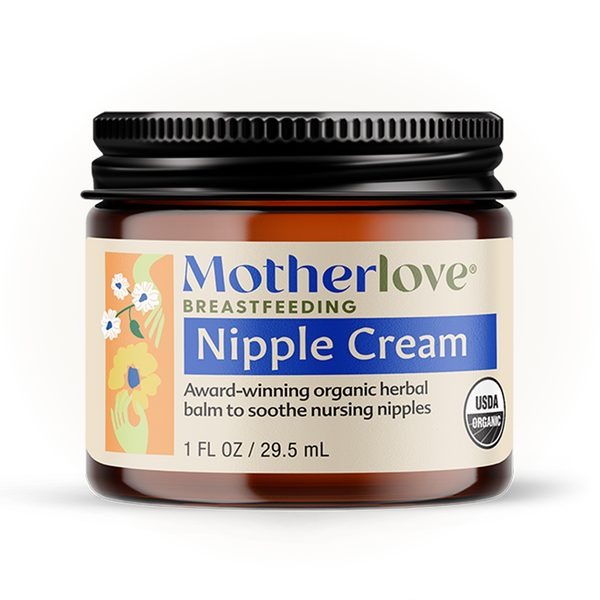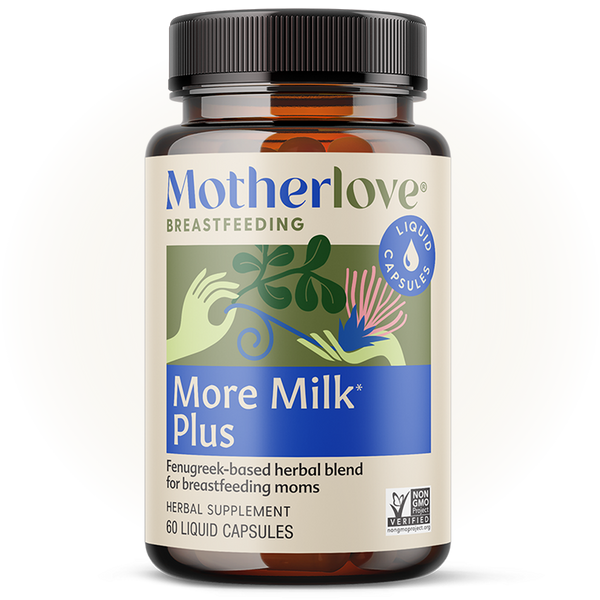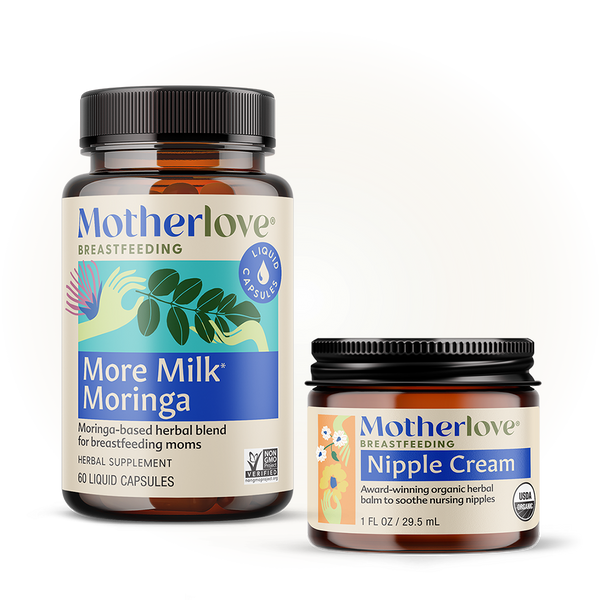Written by Wendy, IBCLC.
Many parents end up supplementing their breastfed baby with pumped breast milk. This often starts in the early weeks of breastfeeding—for example, if you have a baby who’s having trouble latching or if you are having trouble establishing a full milk supply. Parents whose babies are in the NICU or are having medical issues also often start pumping breastmilk and feeding this to their babies.
Often, parents find themselves in a position where they are feeding their baby at-breast and combining this with feeding their baby pumped milk. Feeding babies this way is wonderful, because it means that your baby is getting as much breastmilk as possible while you continue to stimulate and maintain your milk supply by pumping. But it can also be an exhausting and confusing process.
Parents who are triple-feeding this way (pumping, breastfeeding, and bottle-feeding pumped milk) often have lots of questions and concerns. To learn more about triple-feeding specifically, check out our blog. Parents may want to know how to determine how much pumped milk to feed their babies, how to ensure that their baby is getting enough, and how to transition from pumping and bottle-feeding to full breastfeeding.
Here, we’ll take a closer look at these questions and concerns.
HOW MUCH TO SUPPLEMENT
One of the biggest concerns that pumping/breastfeeding parents have is how much to supplement their baby when they are also bottle-feeding them. The answer is: It depends. There isn’t one answer for every parent/baby pair. In some ways, supplementing is an art rather than a science. Still, there are some guidelines and options that can help point you in the right direction.
CONSIDER DOING A PRE- AND POST-FEED
If possible, it can be good to meet with a lactation consultant while you are supplementing who can do a pre- and post-feed of you and your baby. This can give you a ballpark figure of how much milk your baby is taking at the breast and help you estimate how much supplement your baby needs in addition to breastfeeding.
It’s simple to do. Your lactation consultant will weigh your baby before you feed and then weigh your baby after you feed. Whatever weight your baby gained is how much milk they took at your breast.
Lactation consultants have very sensitive scales that you can measure these small differences in weight, so it’s not something you can do on your own with a regular baby scale. It’s important to understand, too, that looking at one feeding only can’t give you the full picture of how much your baby takes at the breast from one feed to another.
DETERMINE HOW MUCH MILK YOUR BABY NEEDS PER FEEDING
Getting an estimate of how much milk your baby needs in total in one feeding can help you estimate how much supplement they need. Some of it will be guesswork unless you know how much your baby is taking at your breast. But understanding what they need in total per feed can help you estimate how much you need to supplement and can ensure you aren’t overfeeding your baby.
The way to determine your baby’s feeding needs is fairly simple. What you do is estimate how many feedings per day your baby is taking and then divide this number by the amount of milk your baby needs in 24 hours, based on their age.
Here’s what to know about breastmilk totals based on age:
- In the first week of life, babies need: 10-12 ounces in 24 hours
- Weeks two and three, babies need: 15-25 ounces in 24 hours
- Four weeks to six months, babies need: 25-35 ounces in 24 hours
So, for example, let’s say you have a two-week old baby who nurses every two hours, or about 10 times a day. You can estimate that your baby needs about 1.5 to 2.5 ounces per feeding. Or, let’s say you have a baby who’s about two months old, and that baby breastfeeds about eight times in 24 hours. This baby needs between 3 and 4 ounces per feed.
HOW TO KNOW BABY IS GETTING ANOUGH
If you are balancing breastfeeding with supplementing, it is essential that you monitor your baby’s growth, ensuring they are gaining weight. This can help you know that what you are doing is working. Monitoring your baby’s growth usually involves doing a weigh-in at the doctor’s office every week or every other week, at least in the early weeks of life. If your baby is gaining an appropriate amount of weight, you know that your routine pumping/bottle-feeding/breastfeeding routine is working, or if you need to tweak the amount that you are supplementing.
BEST PRACTICES WHILE SUPPLEMENTING AND BOTTLE FEEDING
If you are a triple-feeding parent, your goal is likely to make your baby’s experience of feeding as close to exclusive breastfeeding as possible. Most parents are also hoping to transition to full breastfeeding in the future. There are a few things you can do to keep this goal in the forefront.
FOLLOW BABY'S FEEDING CUES
Unless you did a pre- and post-feed for every feeding at your breast, you wouldn’t be able to determine exactly how much supplement your baby needs. As such, supplementing is also about following your baby’s feeding cues as much as possible. Some things you can do to make sure you are following your baby’s feeding cues include:
- Feed your baby when they show signs of hunger (rooting, licking lips, fussing) rather than what time it is on the clock
- When breastfeeding, let your baby determine the length of the feeding, continuing to offer the breast (and the other breast!) until they lose interest
- When bottle-feeding, use paced bottle feeding (holding the bottle horizontally, giving your baby frequent breaks) so that you aren’t overfeeding the supplement
MAKE AT-BREAST FEEDING A PRIORITY
There are many different ways to offer supplements while doing a combo of at-breast feeding and bottle-feeding. If your goal is to increase feeding at the breast and not make baby too reliant on bottle-feeding, there are some strategies to keep in mind:
- You can start your baby on the breast before offering them the supplement; make sure to offer both breasts and only switch to the bottle when your baby is no longer vigorously drinking
- You can consider letting your baby come back to the breast after bottle-feeding for a snack/dessert so that your baby associates breastfeeding with both the beginning and end of a feed and the feeling of satisfaction
- You can consider utilizing methods such as breast hand expressing, where you gently squeeze your breast so that more milk flows, to help prolong the feeding time at the breast
TRANSITIONING TO MORE AT-BREAST FEEDINGS
As your baby grows older and as any breastfeeding problems are solved, it may be possible to wean off bottle-feeding and move to full breastfeeding. The best way to do this is to offer the breast to your baby more frequently and provide tons of opportunities for your baby to breastfeed. As you do this, you will very gradually decrease the amount of supplement you are feeding your baby by bottle.
How much to decrease the supplement is best determined by you and your lactation consultant or pediatrician. It’s also important that you monitor your baby’s growth frequently as you make this transition. In general, though, most people are able to decrease the amount of supplement by a few ounces a day (between 2-6 ounces), every few days.
For example, let’s say you determine you want to decrease the amount you supplement by four ounces in a 24-hour period. You would divide four by the number of times you breastfeed/supplement in 24 hours. If you feed your baby 8 times in 24 hours, you would feed them about ½ ounce less per feeding. Usually, people continue to decrease the amount every two days or so until their baby is taking most of all of their feeds completely at the breast.
Another way to decrease bottle-feeds is to eliminate one bottle-feed every few days until you and your baby adjust. Usually, it’s easiest to start by eliminating a feed where your baby generally takes in a lot of breastmilk at the breast, such as the morning feed.
NO TWO PARENTS ARE ALIKE
As you navigate mixing bottle-feeding and breastfeeding and finding a groove that works, remember that you and your baby are unique. So, what works for you in terms of how many feeds are at the breast vs. bottle is not the same as what works for someone else. It’s also important to remember that working out the kinks in breastfeeding takes time and patience and that you aren’t meant to do it alone. Please reach out for help and support as you navigate this journey.







